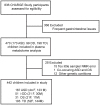Association Between Plasma Metabolites and Psychometric Scores Among Children With Developmental Disabilities: Investigating Sex-Differences
- PMID: 33414730
- PMCID: PMC7783080
- DOI: 10.3389/fpsyt.2020.579538
Association Between Plasma Metabolites and Psychometric Scores Among Children With Developmental Disabilities: Investigating Sex-Differences
Abstract
Background: Developmental disabilities are defined by delays in learning, language, and behavior, yet growing evidence has revealed disturbances in metabolic systems that may also be present. Little is known about whether these metabolic issues contribute to the symptoms or severity of these disabilities, or whether sex plays a role in these associations, given that boys are disproportionately affected by some developmental disabilities. Here we sought to investigate the correlation between psychometric scores, sex, and the plasma metabolome. Methods: The plasma metabolomes of children with autism spectrum disorder (ASD; n = 167), idiopathic developmental delay (i-DD; n = 51), Down syndrome (DS; n = 31), and typically developing controls (TD; n = 193) were investigated using NMR spectroscopy. Spearman rank correlations and multiple linear regression models (adjusted for child's neurodevelopmental diagnosis, child's sex, child's age, child's race/ethnicity, maternal age at child's birth, and parental homeownership) were used to examine the association between plasma metabolites and sex in relation to psychometric measures of cognitive skills, adaptive behavior, and maladaptive behavior in our study population. Results: Higher levels of metabolites involved in cellular energy and mitochondrial function among children with ASD (fumarate and cis-aconitate), DS (lactate), and TD (pyruvate) are associated with poorer cognitive and adaptive subscales. Similarly, higher o-acetylcarnitine associated with deficits in cognitive subscales among all DS cases and TD boys, and carnitine correlated with increased maladaptive behavior among girls with ASD and girls with DS. Among children with DS, elevated myo-inositol, ornithine, and creatine correlated with poorer scores across several subscales. Even among TD cases, elevated 3-hydroxybutyrate correlated with decreased receptive language. In contrast, higher levels of glutamate were associated with better socialization skills among ASD cases. Even after adjusting for the child's neurodevelopmental diagnosis, sex, and other possible confounders, key metabolites including glycolysis metabolites (lactate and pyruvate), ketone bodies (3-hydroxybutyrate and acetoacetate), TCA cycle metabolites (cis-aconitate and fumarate), as well as ornithine were associated with deficits in multiple domains of cognitive function, adaptive skills, and aberrant behaviors. Conclusions: Our results highlight that some plasma metabolites may relate to specific functional subdomains within cognitive, adaptive, and behavioral development with some variation by diagnosis and sex.
Keywords: adaptive behavior; autism spectrum disorder; cognitive scores; down syndrome; maladaptive behavior; metabolites; metabolomics; sex-differences.
Copyright © 2020 Sotelo-Orozco, Abbeduto, Hertz-Picciotto and Slupsky.
Conflict of interest statement
The authors declare that the research was conducted in the absence of any commercial or financial relationships that could be construed as a potential conflict of interest.
Figures







Similar articles
-
The Association Between Gastrointestinal Issues and Psychometric Scores in Children with Autism Spectrum Disorder, Developmental Delays, Down Syndrome, and Typical Development.J Autism Dev Disord. 2025 Jul;55(7):2452-2462. doi: 10.1007/s10803-024-06387-2. Epub 2024 May 13. J Autism Dev Disord. 2025. PMID: 38739245 Free PMC article.
-
Metabolomics analysis of children with autism, idiopathic-developmental delays, and Down syndrome.Transl Psychiatry. 2019 Oct 3;9(1):243. doi: 10.1038/s41398-019-0578-3. Transl Psychiatry. 2019. PMID: 31582732 Free PMC article.
-
Metabolomics of mothers of children with autism, idiopathic developmental delay, and Down syndrome.Sci Rep. 2024 Dec 30;14(1):31981. doi: 10.1038/s41598-024-83587-x. Sci Rep. 2024. PMID: 39738617 Free PMC article.
-
Joint attention in Down syndrome: A meta-analysis.Res Dev Disabil. 2018 Jul;78:89-102. doi: 10.1016/j.ridd.2018.03.013. Epub 2018 May 21. Res Dev Disabil. 2018. PMID: 29793102 Free PMC article. Review.
-
Neurodevelopmental readiness of children for participation in sports.Transl Pediatr. 2017 Jul;6(3):167-173. doi: 10.21037/tp.2017.05.03. Transl Pediatr. 2017. PMID: 28795007 Free PMC article. Review.
Cited by
-
Methods to Improve Molecular Diagnosis in Genomic Cold Cases in Pediatric Neurology.Genes (Basel). 2022 Feb 11;13(2):333. doi: 10.3390/genes13020333. Genes (Basel). 2022. PMID: 35205378 Free PMC article. Review.
-
Metabolomic Signatures of Autism Spectrum Disorder.J Pers Med. 2022 Oct 17;12(10):1727. doi: 10.3390/jpm12101727. J Pers Med. 2022. PMID: 36294866 Free PMC article.
-
Metabolite profiling of peripheral blood plasma in pigs in early postnatal life fed whole bovine, caprine or ovine milk.Front Nutr. 2023 Sep 26;10:1242301. doi: 10.3389/fnut.2023.1242301. eCollection 2023. Front Nutr. 2023. PMID: 37823089 Free PMC article.
-
Alterations of serum metabolic profile in major depressive disorder: A case-control study in the Chinese population.World J Psychiatry. 2025 May 19;15(5):102618. doi: 10.5498/wjp.v15.i5.102618. eCollection 2025 May 19. World J Psychiatry. 2025. PMID: 40495854 Free PMC article.
-
Metabolic Perturbations Associated with both PFAS Exposure and Perinatal/Antenatal Depression in Pregnant Individuals: A Meet-in-the-Middle Scoping Review.Curr Environ Health Rep. 2024 Sep;11(3):404-415. doi: 10.1007/s40572-024-00451-w. Epub 2024 Jun 19. Curr Environ Health Rep. 2024. PMID: 38898328 Free PMC article.

